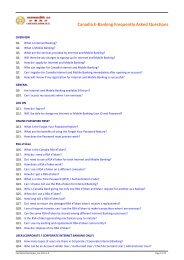Annual report 2009-OK.qxp - Canadia Bank Plc.
Annual report 2009-OK.qxp - Canadia Bank Plc.
Annual report 2009-OK.qxp - Canadia Bank Plc.
You also want an ePaper? Increase the reach of your titles
YUMPU automatically turns print PDFs into web optimized ePapers that Google loves.
<strong>Canadia</strong> <strong>Bank</strong> <strong>Plc</strong>.31. FINANCIAL RISK MANAGEMENT (continued)31.1 Credit risk (continued)a) Credit risk measurementThe <strong>Bank</strong> assesses the probability of default of individual counterparties using internal rating tool. Creditcommittee is responsible for determining the risk rating for each borrower.In measuring credit risk of loans and advances to customers at a counterparty level, the <strong>Bank</strong> reflects the ninerisk rating grades which are: (i) minimal risk, (ii) below average risk, (iii) average risk, (iv) above average risk, (v)higher than above average risk but still acceptable, (vi) watch, (vii) substandard, (viii) doubtful and (ix) loss.Risk ratings are reviewed and updated at least annually, and in event of change of loan terms and conditionsincluding extension; repayment irregularities or delinquencies; and adverse information relating to theborrower or transaction.b) Risk limit control and mitigation policiesThe <strong>Bank</strong> operates and provides loans and advances to individuals or enterprises within the Kingdom ofCambodia.The <strong>Bank</strong> manages, limits and controls the concentration of credit risk whenever it is identified. Largeexposure is defined by the NBC as overall credit exposure to any individual beneficiary which exceeds 10% ofthe <strong>Bank</strong>'s net worth.The <strong>Bank</strong> is required, under the conditions of Prakas No. B7-06-226, to maintain at all times a maximum ratio of20% between the <strong>Bank</strong>'s overall credit exposure to any individual beneficiary and the <strong>Bank</strong>'s net worth. Theaggregation of large credit exposure must not exceed 300% of the <strong>Bank</strong>'s net worth.The <strong>Bank</strong> employs a range of policies and practices to mitigate credit risk.The most traditional of these is the takingof security in the form of collateral for loans and advances to customers.The <strong>Bank</strong> implements guidelines onthe acceptability of specific classes of collateral or credit risk mitigation. The principal collateral types assecurity for loans and advances to customers are:• Mortgages over residential properties (land, building and other properties);• Charges over business assets such as land and buildings; and• Cash in the form of margin deposits.61<strong>Annual</strong> Report <strong>2009</strong>c) Impairment and provisioning policiesThe <strong>Bank</strong> is required to follow the mandatory credit classification and provisioning in accordance with PrakasB7-09-074 dated 25 February <strong>2009</strong>. The NBC requires commercial banks to classify their loan portfolio into fiveclasses and the minimum mandatory level of specific provision is made depending on the classificationconcerned and regardless of the assets (except for cash) pledged as collateral, as follows:
















